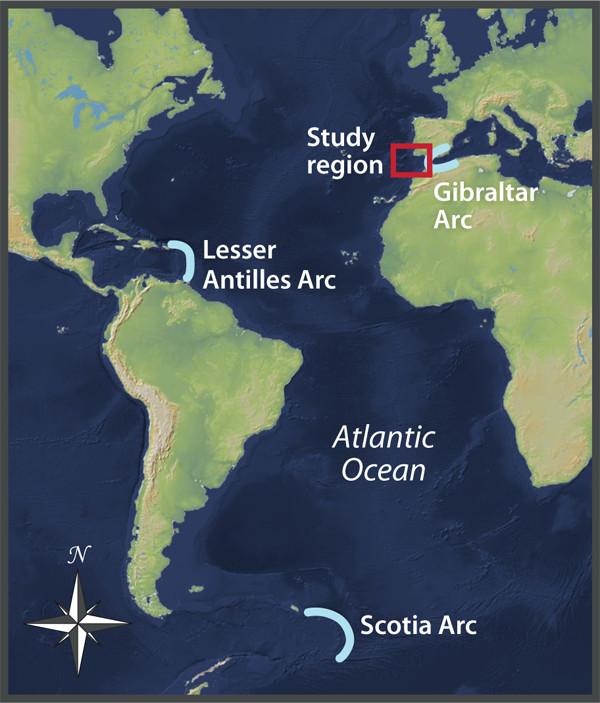
by Mary Caperton Morton Wednesday, September 4, 2013

The Atlantic Ocean currently has three subduction zones: in the Caribbean, the South Atlantic and the Mediterranean. A new one may be forming off the coast of Portugal. Kathleen Cantner, AGI
“Every first-year geology student learns about the Wilson Cycle: Oceans open and then new subduction zones form and the oceans close,” says Robert Stern, a geoscientist at the University of Texas at Dallas. Throughout the history of the Earth, supercontinents and ocean basins have opened and closed over timescales of 300 million to 500 million years. “But we don’t actually see evidence” of the in-between phase — a previously opening ocean basin beginning to close — “happening anywhere on Earth,” Stern says. Now, thanks to new high-resolution surveys of the seafloor, scientists think they have evidence of that process starting in the Atlantic Ocean, off the coast of Portugal.
How passive margins like the eastern coast of North America transform into subduction zones that could eventually close ocean basins is a long-standing mystery. Some scientists have proposed that the weight of sediments accumulating along passive margins could cause the edge of a passive margin to begin to sink and eventually subduct, but the largest sediment basins on Earth — the Gulf of Mexico and the Bay of Bengal — show no evidence of such a process happening. And so far, other forces that may drive this passive-to-active-margin transformation have remained unknown. What is known is that new subduction zones must form to accommodate the young oceanic crust forming at mid-ocean ridges since tectonic processes are ultimately governed by a single constraint: the circumference of the Earth must remain the same.
In a new study in Geology, João Duarte, a geophysicist at Monash University in Melbourne, Australia, and colleagues at the University of Lisbon in Portugal have proposed that this transformation may occur due to a convergence of compressive forces. The process is related to a theory, first suggested in the early 1990s, that once subduction starts along one margin in a basin, subduction along others tends to follow. Currently, the Atlantic has three isolated subduction zones: the Lesser Antilles in the Caribbean, the Scotia Arc in the South Atlantic, and the Gibraltar Arc in the Mediterranean. Duarte and his colleagues think there may be a new subduction zone forming off the coast of Portugal in connection with the ongoing subduction of the Gibraltar Arc.
Using data from multibeam bathymetry and seismic reflection profiling studies, Duarte and his colleagues created a new map of the region and identified the main tectonic driving mechanisms: the westward movement of the Gibraltar Arc and the convergence of the African and Eurasian plates. Combined, the tectonic movements generate compressive stresses at the southwest Iberian passive margin off the coast of Portugal that could be forcing the plate downward to form a new subduction zone.
“This area is very complex and there have always been a lot of competing and apparently contradictory models,” Duarte says. “Our model unifies previously contradictory models of this region in a consistent framework that accounts for all of the present structures.”
Duarte says it’s too early in the evolution of the new subduction zone for all the typical subduction features to have formed. “It’s important to keep in mind that we don’t have a fully developed and mature subduction zone here yet. What we have is a set of thrust faults that extend for 300 kilometers along the margin — exactly what you would expect to see just before a subduction zone initiates.”
But Stern, who wasn’t involved in the recent study, says he is unconvinced that thrust faults alone are sufficient evidence to declare the southwest Iberian margin a nascent subduction zone, mainly because it’s just too early to tell, he says. There’s no deep seismicity or volcanic arc yet — two hallmarks of subduction zones.
If the convergence continues the way Duarte and his colleagues suggest, the margin may take another 10 million to 20 million years to develop into a mature subduction zone, Duarte says. Whether this will lead to the closing of the Atlantic is “extremely speculative,” Duarte says. Regardless, it won’t happen any time soon. “The Atlantic Ocean is about 200 million years old,” Duarte says. “If the process is reversed [and the ocean basin closes], it’s likely that it will take another 200 million years to close.”
© 2008-2021. All rights reserved. Any copying, redistribution or retransmission of any of the contents of this service without the expressed written permission of the American Geosciences Institute is expressly prohibited. Click here for all copyright requests.